The AMD Radeon R9 Nano Review: The Power of Size
by Ryan Smith on September 10, 2015 8:00 AM ESTOverclocking
Finally, no review of a high-end video card would be complete without a look at overclocking performance.
Of all of the Fiji cards overclocking the R9 Nano is perhaps the easiest and certainly the most unusual. Due to the fact that the card is essentially a 1000MHz Fiji card with a heavy power throttle, the card is already validated for clockspeeds that under load it doesn’t have the available power to reach. As a result while one can crank up the clockspeeds, the card isn’t going to move until you increase the power limit. And even then you are more likely to hit the power cap again than you are to break 1000MHz sustained. So overclocking the GPU is something of an academic affair.
| Radeon R9 Fury/Nano Series Overclocking | |||||
| Ref. R9 Fury X | ASUS R9 Fury | Ref. R9 Nano | |||
| Boost Clock | 1125MHz | 1075MHz | 1075MHz | ||
| Memory Clock | 1Gbps (500MHz DDR) | 1.1Gbps (550MHz DDR) | 1.1Gbps (550MHz DDR) | ||
| Power Limit | 100% | 115% | 135% | ||
| Max Voltage | 1.212v | 1.169v | 1.2v | ||
Overall we were able to overclock our sample to 1075MHz on the GPU and 550MHz (1.1Gbps) on the memory. However load clockspeeds were almost always under 1000MHz even with a generous 35% increase in the power target. Overdrive does allow for a larger increase – up to 50% – but with the R9 Nano featuring a less robust power delivery system designed to push less power than R9 Fury or R9 Fury X, we’re hesitant to increase the limit further without a better idea of what the card can safely sustain for extended periods of time.
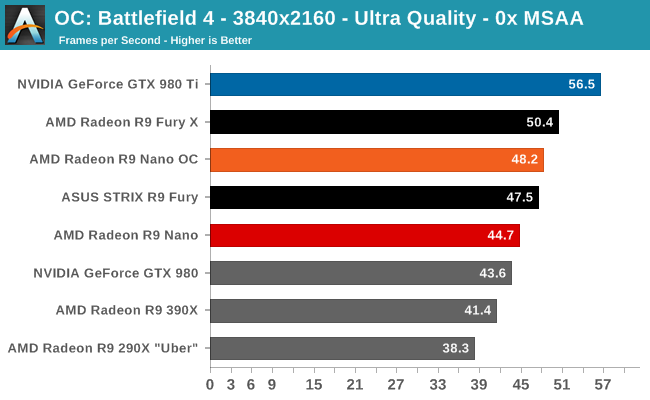

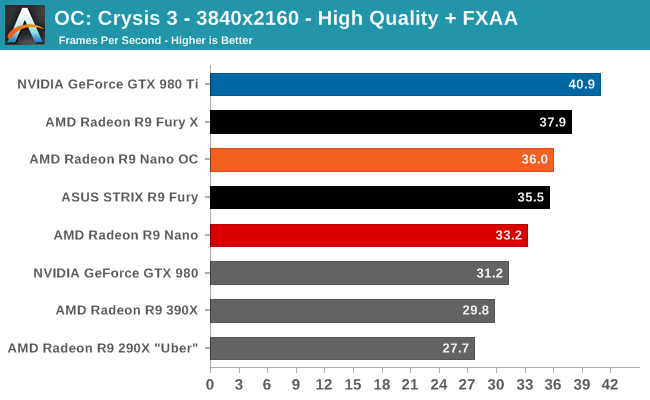
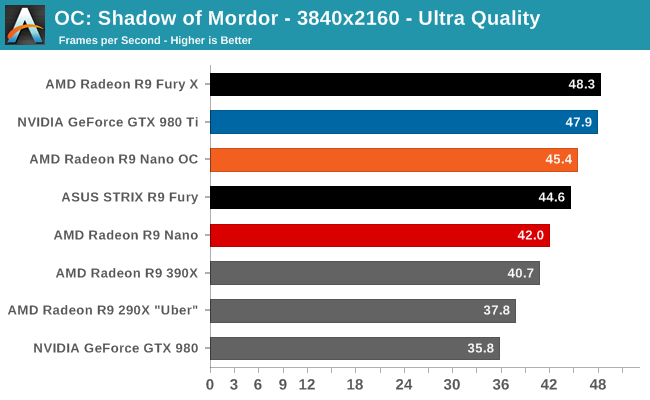
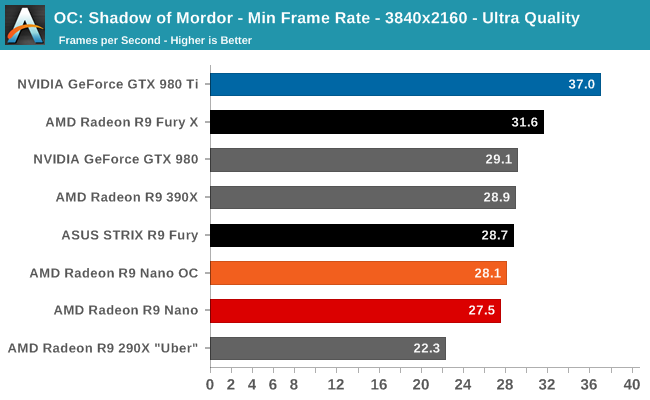
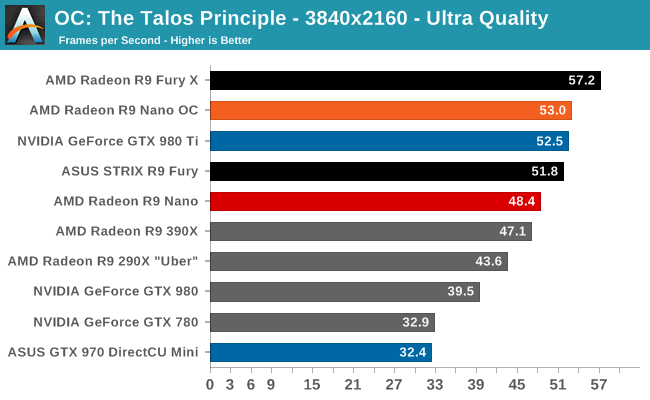
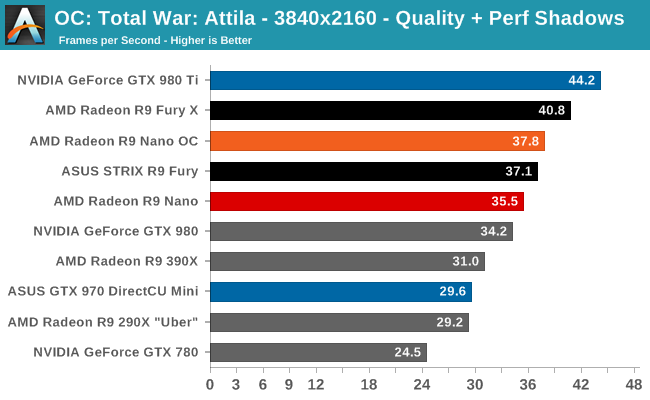
The overall performance gains from overclocking aren’t huge, but at 7-10% they also aren’t too shabby. However since higher clockspeeds quickly ramp up the power requirements due to the higher voltages required, the performance gains won’t be anywhere near the 35% increase in the power limit, despite that we are in fact still power limited.
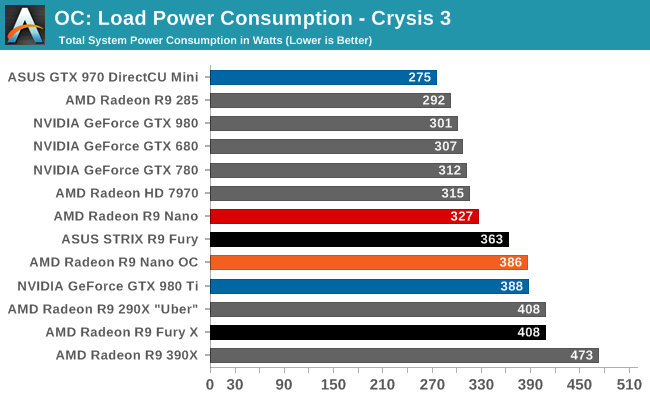
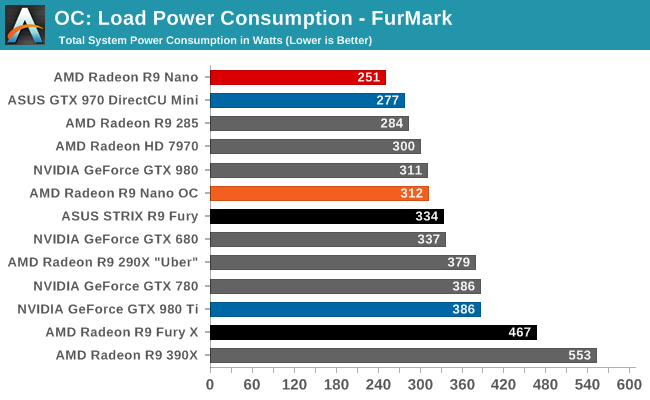
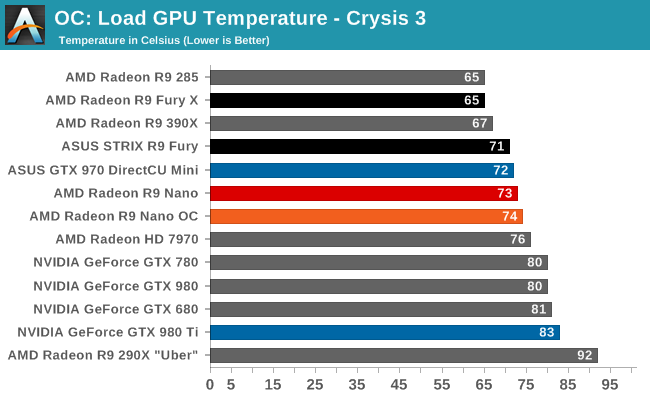
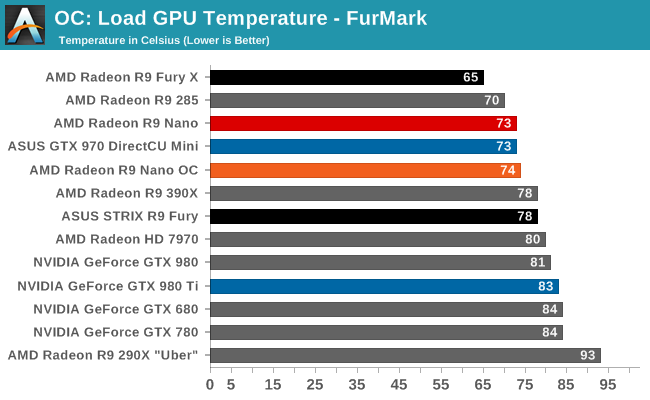
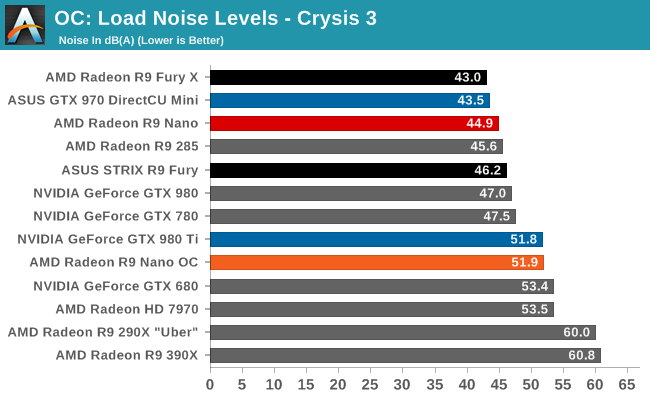
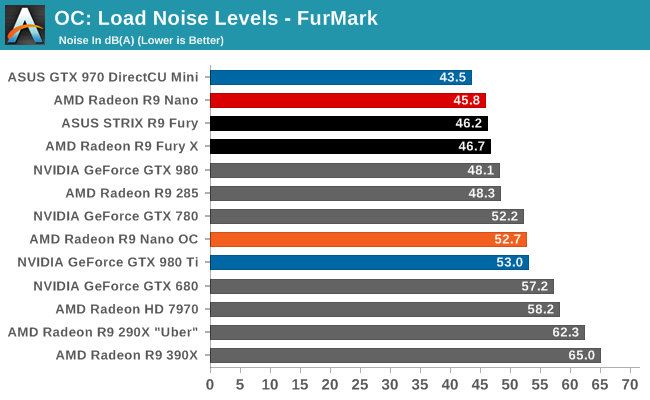
Meanwhile the 35% increase in the power limit has a definite knock-on effect on the cooling system. The R9 Nano’s cooler is able to keep up with the additional load, holding temperatures to 74C, but noise levels are now over 51dB(A). Power consumption at the wall is similarly affected, with the R9 Nano essentially giving up all of its energy efficiency gains in the process.










284 Comments
View All Comments
Jm09 - Friday, September 11, 2015 - link
Yes I'm aware, but the nano is binned for the highest quality chips. I wish they would of released two models where one was clocked lower and didn't have binned chips. That alone increased the price of this chipMaddyScientist - Thursday, September 10, 2015 - link
It would be nice to use the latest version of LuxMark 3.1, as this has optimizations for both AMD and NVIDIA GPUs, that makes it run faster on more recent GPUs. This would would give a better picture of the compute benefits of these new GPUS.at80eighty - Friday, September 11, 2015 - link
Ryan, i realise it's a test bench, but that cable management is making me twitchy :)Ryan Smith - Friday, September 11, 2015 - link
Noted and agreed. It wasn't really built for public display, it was thrown together for video recording. Small computers are nice, but they're hard to quickly route cables in, especially with my giant hands.awstar - Friday, September 11, 2015 - link
Review > Compute > Vegas: The Vegas benchmark has peaked. The reviewers should post stats on timeline playback performance, or upgrade the test file to 4K XAVC 32-bit float project levels. This would show a much greater difference between the modern GPUs.Haravikk - Friday, September 11, 2015 - link
It's great to see a card like this; finally a proper high end for half-length cards. While there are some good Mini-ITX cases that can take full-length cases, they end up so long that it kind of defeats the point of building small, but half-length cards are usually more in the budget to mid-range bracket, or a generation behind, either way it means a big sacrifice in going small.Hopefully we'll see more competition in this case, as I'm one of those who, in going small, is fine with paying a premium to still remain fairly competitive while doing so.
Regarding the idle noise level though; I still find it weird that there isn't better support out there for switching from integrated to discrete GPUs. Since most people still favour Intel processors this would make a lot of sense given that they have integrated graphics, plus in the Mini-ITX size on the AMD side it can be more cost effective to get an APU anyway. If the integrated GPU could take over for desktop stuff, browsing etc. like we see on laptops, then it would leave the Nano to just function as a set of video interfaces, which would be much better.
Alternatively, I wonder if they could even just add an APU type GPU as a low-power alternative onto the card; i.e- with a light load and low VRAM requirements it would take over and just use some low cost RAM (or even system RAM) so that the rest of the card can be shut off entirely.
Peichen - Friday, September 11, 2015 - link
Modern graphic card only draws single-digit watt power at idle/2D so the whole hybrid GPU idea was dropped. Routing video through integrated GPU also reduce performance by 2-3% and taken into account the complexity involved with driver just to save 8w makes no sense.atomsymbol - Friday, September 11, 2015 - link
R9 Nano: 4096 SP, 1 GHz, 512 GB/s => x+5 FPS, price y+$220R9 390X: 2816 SP, 1.05 GHz, 384 GB/s => x FPS, price y
+35% computational power => +5 FPS
Mathos - Friday, September 11, 2015 - link
After having read this review. All I can really think of to say about the Nano, is they should of priced it at least the same as the regular R9 Fury. That way you'd easily get GTX 980 performance in a itx form factor, for close to the same price. I must say your review seems a bit more fair than Toms hardware. Somehow they had a regular 980 outperforming the FuryX, so I was like wth Toms.I personally had been waiting for the Nano reviews to come out, before deciding what to get. But going by the price, it looks like I'll be getting an R9 Fury, so I can run most games in VSR 1440p, scaled down to 1080p. Either that or I'll just cap my fps at 65 and save power. Should do well once more DX12 games come out too.
itproflorida - Friday, September 11, 2015 - link
you have no idea what your talking about its all speculation. thank you